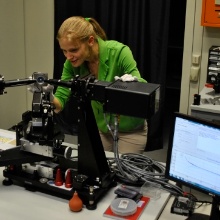At the end of the 19th century, Paul Drude used the polarization change of a light beam reflected off a sample surface to determine the optical properties of materials and to measure layer thicknesses in the nm range. The occurring elliptically polarized light gives rise to the name ellipsometry, which was developed form these first measurements.
Today, ellipsometry is one of the most powerful techniques for the determination of the optical properties of surfaces and thin films.
The principle of ellipsometry is based on the fact that the different polarization states of a electric field, parallel Ep and perpendicular Es to the plane of incidence, are reflected with different intensities. So the resulting polarization state is generally elliptic. This elliptically polarized light can be described via the so-called ellipsometric angles Ψ and Δ, which are defined by the complex Fresnel reflection coefficients rp und rs:
First, the unpolarized light coming from a light source is linearly polarized. Due to the interaction with the sample surface, the polarization state changes to elliptic. The rotating analyzer modulates the intensity of the reflected light with twice the rotation frequency. Via Fourier analysis of amplitude and phase of the detected signal the ellipsometric angles Ψ and Δ can be calculated.
Since Ellipsometry is an indirect measuring method, it is necessary to model the optical response of the investigated sample. Here, all fitting parameters such as film thickness or optical constants are varied in an iterative process until they match the experimental data. The only exception is the case of an isotropic sample where only the air-sample interface is considered (p. ex. bulk materials). In this simple case the optical constants can directly be calculated from the angles Ψ and Δ.
The ellipsometer used at our institute is a Variable Angle Spectroscopic Ellipsometer (VASE) from J. A. Woollam which allows a computer controlled variation of the angle of incidence. Additionally the azimuth angle of the sample can be varied which is very important for the characterization of anisotropic or nanostructured samples.





